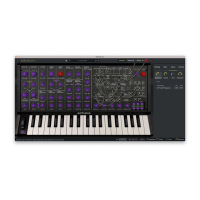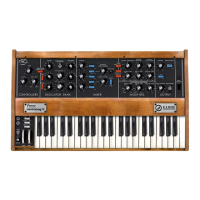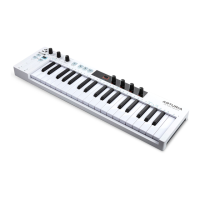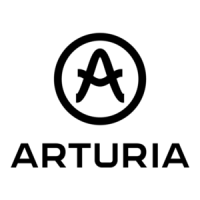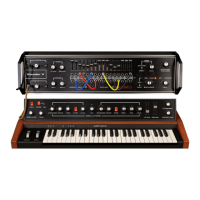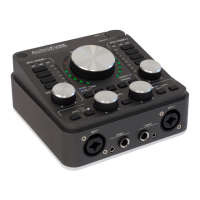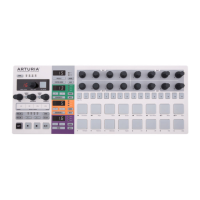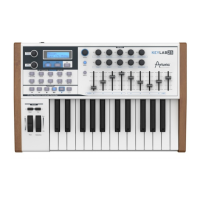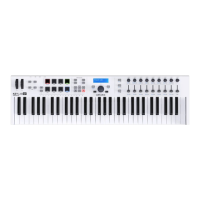Do you have a question about the Arturia MINILAB 3 and is the answer not in the manual?
Introduces the MiniLab 3 as a compact MIDI keyboard controller with extensive features usually found on larger keyboards.
Lists the key features and specifications of the MiniLab 3 controller, including its keyboard, pads, encoders, and connectivity.
Details the controls and features on the front panel of the MiniLab 3, including buttons, knobs, faders, and the display.
Describes the connections and ports located on the rear panel of the MiniLab 3, such as Kensington lock, MIDI Out, and USB-C.
Explains how the OLED display shows control values and feedback when interacting with the device's knobs and pads.
Details the alternate functions accessed by holding the Shift button in combination with other controls.
Explains how to adjust the keyboard's octave and transpose settings using the dedicated Octave buttons.
Describes the function and operation of the pitch-bend and modulation touch strips on the controller.
Introduces the eight velocity and pressure-sensitive performance pads and their primary functions.
Explains the alternate functions of the pads when the Shift button is engaged, including DAW transport.
Covers pad banks, ARTURIA mode, DAWs mode, and User Programs for controlling the MiniLab 3.
Introduces the built-in arpeggiator and its capabilities for creating rhythmic patterns from held chords.
Explains how to turn the Arpeggiator on and off using the Shift button and Pad 1.
Details the procedure to enter and exit the Arpeggiator's editing interface for parameter adjustment.
Guides on editing Arpeggiator parameters like Mode, Division, and Rate using the main encoder knob.
Explains using the eight encoder knobs for quick access to Arpeggiator settings like On/Off, Mode, and Swing.
Provides detailed explanations for each parameter within the Arpeggiator settings, including Rate, Sync, and Octave.
Describes the different play modes available for the Arpeggiator (Up, Down, Inc, Exc, Rand, Order).
Explains the rhythmic subdivision settings for the Arpeggiator relative to tempo, including triplet feel options.
Details how the Swing parameter affects the rhythmic feel of the Arpeggiator by delaying notes.
Explains the Gate time parameter, which controls note duration and articulation in the Arpeggiator.
Describes how to set the Arpeggiator's rate in beats per minute, dependent on the Sync setting.
Explains the Sync options for the Arpeggiator (Internal vs. External tempo) for synchronization.
Details the Octave range setting for the Arpeggiator, allowing notes to play across multiple octaves.
Explains how to set the Arpeggiator's tempo by tapping the desired beat on Pad 8.
Describes the Hold function for sustaining notes played on the keyboard until a new note is played.
Introduces Chord Mode, which memorizes and plays user-created chords from a single key press.
Guides on how to create and memorize a custom chord by playing notes on the keyboard.
Explains the interaction and combined functionality of the Arpeggiator, Chord Mode, and Hold Mode.
Describes Vegas Mode, an idle screen saver-like feature for the MiniLab 3 that displays cycling colors.
Details the procedure for resetting the MiniLab 3 to its factory default settings and erasing user data.
Discusses customization options, macros, and generic MIDI control capabilities with Arturia instruments.
Covers the essential steps for setting up audio and MIDI connections with Analog Lab software.
Explains how to configure MIDI settings within Analog Lab for proper control and communication.
Details how to browse and select sound presets within Analog Lab using the main encoder knob.
Explains how to navigate and filter presets by category (Types) in Analog Lab's browser.
Provides instructions on navigating through Analog Lab's preset hierarchy (Types and Sub-Types) using the controller.
Describes the default assignments of knobs and faders to parameters for live performance and studio tweaking.
Details the assignment of the first four knobs to Arturia instrument Macros for parameter control.
Explains the assignment of knobs 5-8 to effects parameters within Analog Lab, such as Flanger Mix and Delay Volume.
Covers the assignment of the four faders to master volume and EQ controls on Analog Lab's master output.
Outlines the default MIDI notes sent by the MiniLab 3 pads when used with Analog Lab.
Explains how to control integrated DAWs like Ableton Live, Logic Pro, and others using the MiniLab 3.
Details how to use pads 4-8 for DAW transport functions like Loop On/Off, Stop, Play, and Record.
Describes controlling DAWs without custom scripts using the Mackie Control Universal protocol.
Explains how to run MiniLab 3 in its dedicated Analog Lab mode for integrated control within a DAW.
States that the software components must be used together as a single product and not modified.
Covers the conditions and limitations for assigning software usage rights to another person.
Disclaims Arturia's liability for indirect or consequential damages arising from product use.
Introduces the MiniLab 3 as a compact MIDI keyboard controller with extensive features usually found on larger keyboards.
Lists the key features and specifications of the MiniLab 3 controller, including its keyboard, pads, encoders, and connectivity.
Details the controls and features on the front panel of the MiniLab 3, including buttons, knobs, faders, and the display.
Describes the connections and ports located on the rear panel of the MiniLab 3, such as Kensington lock, MIDI Out, and USB-C.
Explains how the OLED display shows control values and feedback when interacting with the device's knobs and pads.
Details the alternate functions accessed by holding the Shift button in combination with other controls.
Explains how to adjust the keyboard's octave and transpose settings using the dedicated Octave buttons.
Describes the function and operation of the pitch-bend and modulation touch strips on the controller.
Introduces the eight velocity and pressure-sensitive performance pads and their primary functions.
Explains the alternate functions of the pads when the Shift button is engaged, including DAW transport.
Covers pad banks, ARTURIA mode, DAWs mode, and User Programs for controlling the MiniLab 3.
Introduces the built-in arpeggiator and its capabilities for creating rhythmic patterns from held chords.
Explains how to turn the Arpeggiator on and off using the Shift button and Pad 1.
Details the procedure to enter and exit the Arpeggiator's editing interface for parameter adjustment.
Guides on editing Arpeggiator parameters like Mode, Division, and Rate using the main encoder knob.
Explains using the eight encoder knobs for quick access to Arpeggiator settings like On/Off, Mode, and Swing.
Provides detailed explanations for each parameter within the Arpeggiator settings, including Rate, Sync, and Octave.
Describes the different play modes available for the Arpeggiator (Up, Down, Inc, Exc, Rand, Order).
Explains the rhythmic subdivision settings for the Arpeggiator relative to tempo, including triplet feel options.
Details how the Swing parameter affects the rhythmic feel of the Arpeggiator by delaying notes.
Explains the Gate time parameter, which controls note duration and articulation in the Arpeggiator.
Describes how to set the Arpeggiator's rate in beats per minute, dependent on the Sync setting.
Explains the Sync options for the Arpeggiator (Internal vs. External tempo) for synchronization.
Details the Octave range setting for the Arpeggiator, allowing notes to play across multiple octaves.
Explains how to set the Arpeggiator's tempo by tapping the desired beat on Pad 8.
Describes the Hold function for sustaining notes played on the keyboard until a new note is played.
Introduces Chord Mode, which memorizes and plays user-created chords from a single key press.
Guides on how to create and memorize a custom chord by playing notes on the keyboard.
Explains the interaction and combined functionality of the Arpeggiator, Chord Mode, and Hold Mode.
Describes Vegas Mode, an idle screen saver-like feature for the MiniLab 3 that displays cycling colors.
Details the procedure for resetting the MiniLab 3 to its factory default settings and erasing user data.
Discusses customization options, macros, and generic MIDI control capabilities with Arturia instruments.
Covers the essential steps for setting up audio and MIDI connections with Analog Lab software.
Explains how to configure MIDI settings within Analog Lab for proper control and communication.
Details how to browse and select sound presets within Analog Lab using the main encoder knob.
Explains how to navigate and filter presets by category (Types) in Analog Lab's browser.
Provides instructions on navigating through Analog Lab's preset hierarchy (Types and Sub-Types) using the controller.
Describes the default assignments of knobs and faders to parameters for live performance and studio tweaking.
Details the assignment of the first four knobs to Arturia instrument Macros for parameter control.
Explains the assignment of knobs 5-8 to effects parameters within Analog Lab, such as Flanger Mix and Delay Volume.
Covers the assignment of the four faders to master volume and EQ controls on Analog Lab's master output.
Outlines the default MIDI notes sent by the MiniLab 3 pads when used with Analog Lab.
Explains how to control integrated DAWs like Ableton Live, Logic Pro, and others using the MiniLab 3.
Details how to use pads 4-8 for DAW transport functions like Loop On/Off, Stop, Play, and Record.
Describes controlling DAWs without custom scripts using the Mackie Control Universal protocol.
Explains how to run MiniLab 3 in its dedicated Analog Lab mode for integrated control within a DAW.
States that the software components must be used together as a single product and not modified.
Covers the conditions and limitations for assigning software usage rights to another person.
Disclaims Arturia's liability for indirect or consequential damages arising from product use.
| MIDI out | Yes |
|---|---|
| Interface | USB |
| Control type | Rotary, Slider, Touch |
| Backlight color | Multicolor |
| Keyboard number of keys | 25 |
| MIDI-keyboard number of keys | 25 keys |
| Product color | White |
| Sound effects | Chorus |
| Mac operating systems supported | Mac OS X 10.13 High Sierra |
| Windows operating systems supported | Windows 10 |
| Depth | 220 mm |
|---|---|
| Width | 355 mm |
| Height | 50 mm |
| Weight | 1500 g |
